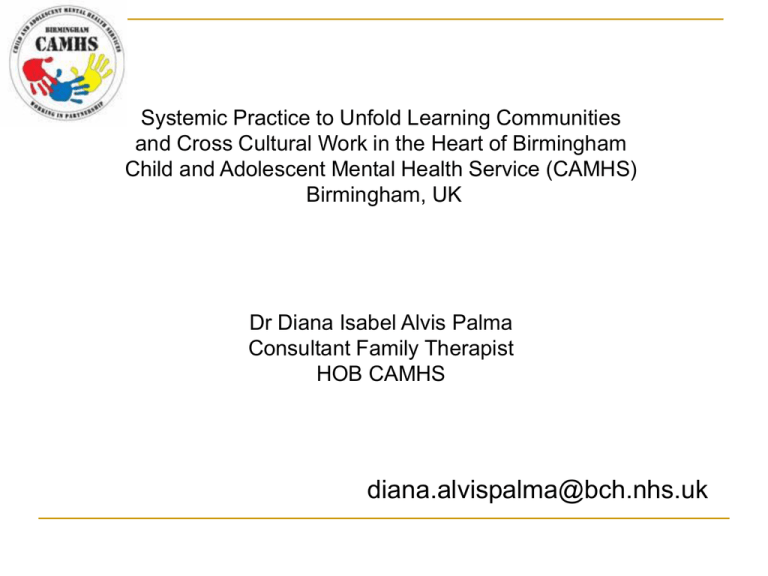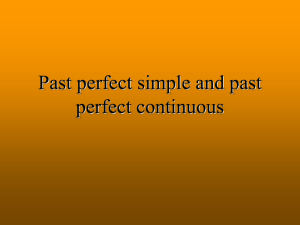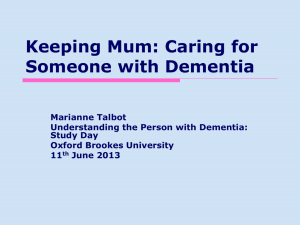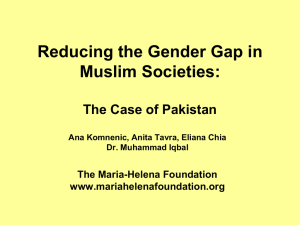the presentation in English (PPT 448Kb)
advertisement

Systemic Practice to Unfold Learning Communities and Cross Cultural Work in the Heart of Birmingham Child and Adolescent Mental Health Service (CAMHS) Birmingham, UK Dr Diana Isabel Alvis Palma Consultant Family Therapist HOB CAMHS diana.alvispalma@bch.nhs.uk INTEGRATION OF CULTURE IN SYSTEMIC PRACTICE Evolved throughout the last 40 years. Stage I: family as a prototype of a white, middle class, heterosexual family, with traditional patriarchal roles, and which is dysfunctional and needs to be fixed. Stage 2: Gender perspective which draws attention to the iniquity of gender roles in the family and the oppression of women. Stage 3: Cultural perspective which includes the dimensions of ethnicity and culture as basic dimensions for the understanding of all families. McGoldrick (1998) Culture emerges at the intersection(s) between multiple systems of meanings rather than simply to be found within one privileged context. Social GRRAACCESS (Burnham, 1992; Roper-Hall 1998) Gender Race Religion Age Ability Class Culture Ethnicity Sexuality Spirituality What experience do you have talking with children, young people and families about culture, including social GRRAACCEESS? What experience do you have talking with colleagues, professionals or other kind of helpers about culture, including social GRRAACCEESS? What experience does your organization have talking with children, young people and families about culture including social GRRAACCEESS? Understanding the Cultural (Religious/Spiritual) Background against which Families/children Live their Lives. “M was referred after having an overdose M let us know that she is struggling with an impossible conflict about how to lead her life, whether to conform to her father’s wishes for a strictly Muslim way of life, or whether to lead a more independent life and make decisions for herself. She does not wear the head scarf but said she may well choose to adopt a more strictly religious lifestyle in her own time” …The overdose was connected with a break up of a relationship with a boyfriend, which M was keen her parents should not know about. …M indicated confusing feelings about her parents. Talked about her father being strict… M is more confused about whether her mother cares for her. She said her mother says hurtful things to her, says she is worthless, a failure… M is jealous of her younger brother (13) who she sees as favoured” Emina’s Story Behavioural difficulties Support at school several kinds Risk of being permanently excluded Referred to CAMHS Referred to Family Therapy – Family conflict. Home Visit Conflict between school and parents Parents: School discrimination School: question parental capacity, ability to put boundaries, colluding with daughter Curious about why receiving letters from school was annoying for the father. Not communication through letters in Bosnia History of being in a concentration camp as context to understand his emotional response to the letters Reflexive about the tension between professional/service knowledge/cultures and family cultures Aesthetically moving within the tension to facilitate stories of change, resources, hope . Learning communities in working contexts Practical knowledge – reflexive and experiential. Knowledge connected to day to day practice. Extend professional practices Change of organizational culture Negotiating and reflecting about what is included and excluded as right, good or legitimate. How to facilitate learning communities to unfold cross-cultural work and cultural competence HEART OF BIRMINGHAM (HOB) CAMHS 70% of non white population in the HOB 60 different languages are spoken. Socio-economically disadvantage area Community mental health service for children and families Multi-disciplinary team One Consultant Systemic Family Psychotherapist A city wide Systemic Family Psychotherapy Department Cross Cultural Family Centre Centre for the innovation in working with BME communities and in training of cultural competence using systemic/narrative/social constructionist ideas. How to facilitate contexts for learning and learning communities Systemic Teams Learning Spaces Space for GRRAACCEESS Supervisory and Training skills Joint work Heath and LAC team Multi-agency consultation team Trainee’s team Experiencing about new ways of working together Multi-agency consultation Networking Training Joint Work with Multi-disciplinary Team Multi-agency Consultation Team One off consultation Tier 1 Across Disciplines Trainees Team Health CAMHS Team + 3 agecies Cross-agency Consultation Networking Training SPACE FOR GRRAACCEES Cross Agency Initiatives What are our ethics? How do they influence our decisions? What is the place of learning? How do we learn? What is our accountability in the organization, its policies and its practices? What are our Duties, Rights and Responsibilities? What kind of team are we, how we construct our relationships? How do we understand families and their situations? Learning communities - Learning Principles Learning is a shared responsibility We are constantly creating and participating in learning contexts Our learning is part of our professional and personal development. We are accountable to ourselves, the group and the organization for our learning. Our learning is collaborative and reflexive. We greatly value learning from families and children We/I are attentive to respond and engage with different ways of learning. Principles informed by experiential and adult and experiential learning and systemic and social constructionist ideas. SPACE FOR GRRAACCEESS Space to have conversations about: How I/we understand and live my/our differences. How different ways of understanding/living the Social GRRAACCEESS might be liberating or oppressing for me/you/us What are like the social GRRAACCEESS in the HOB’s neighbourhoods and families and how they become contexts that influence children’s emotional wellbeing. How Social GRRAACCEESS shape relationships with families and with colleagues. What to look at when integrating the Social GRRAACCEESS in our day to day practice. SPACE for GRAACCEESS in training and supervision: Divac, A & Heaphy, G (2005) What is not THE SPACE FOR GRRAACCESS IT IS NOT A THERAPEUTIC SPACE IT IS NOT AN ACADEMIC SPACE IT IS NOT A CLINICAL CONSULTATION SPACE IT IS NOT A PLANNING OR STRATEGIC MEETING IT IS ONE OF THE CENTRE’S MAIN HOPES/GOALS THAT PROFESSIONALS USE THE LEARNING TO EXTEND THEIR DAY TO DAY PRACTICE WITH SYSTEMIC/SOCIAL CONSTRUCTIONIST/ NARRATIVE SKILLS IN WAYS THAT MAKE SENSE FOR THEIR WORKING CONTEXT. …The family make up and ethnicity was Mum was a single parent muslim with a dual heritage daughter who was part asian and black. When I first met mum she was very distrustful and did not really engage well with me and the first two sessions needed to be introduced with the Play therapist in tow. I recognised as a social worker that sometimes parents take some time to engage and sometime avoid difficult situations. I also recognised that sometimes parents tell their stories to a lot of people and I wondered how forthcoming would I be to tell my story to a complete stranger. I also recognised that I was a black female and I wondered how she felt about this. I decided to explore with her about ethnicity and religion to see how these two influences or did not influence her. I was surprised when I began to discuss with her about her religious beliefs that she expressed strongly that she is a Christian. I began to explore her surname and stated that this sounded like a Muslim name. She agreed. I asked her to tell me more. MT stated that she was in fact brought up in a Muslim family and that she no longer believed in what they believed in. MT had cut and dyed her hair and stated “I no longer dress the way they do”. During sessions after this I noticed that she would quote from the Bible, for which I understood. During further sessions I would ask her questions like “if your mum was here (MT’s mum deceased when she was 14), what would she use the Bible or the Qur’an?”. MT replied that she would use ‘the Qur’an’. We would have lengthy conversation about religion, Bible, Qur’an, ethnicity and about her upbringing. I do not believe that she had realised how much her Muslim identity influence her day to day living. She expressed to me that she did not like to go out on Broad Street, she will not drink, she refuses to sleep around and she does not like lying or deceitfulness. I stated that what she may like doing was to separate the two as being a Muslim does not mean that you are violent (prior to and after this we had discussed in different ways the difficult experiences that had lead her to feel in this way and had impacted on her child being referred to CAMHS, as well as her strengths), that there are good people who are Muslim also. MT would also state I don’t want to be one of them, I want to be a Christian. I asked “Why do you want to be a Christian? MT said it is better they don’t beat their children (historically MT had been physically and mentally abused by her father). Through doing the genogram (MT wrote her genogram in Arabic) I learned that she can speak mirpuri fluently and I can also read Arabic. I asked her if she had taught any of these to her daughter who is dual heritage. MT stated she had taught her a few words but she cannot read Arabic. MT stated that perhaps she wished that she had but because of attachments in the beginning of having her daughter she did not do this. I found that she would discuss with me about her daughter being dual heritage By the end of the therapeutic work she was much in touch with her Asian ethnicity. She was more keen to go into Asian areas and she started going into her daughter’s school which was predominantly an Asian school. She allowed her daughter to bring friends around of different ethnicity and accepting that her daughter was more into Asian music that she was. It helped the girl to explore more freely about who she was. Senior Social Worker I feel that religion was central to the recovery and steps forward that I and her mother were able to take on a number of levels. Further to this, I would go as far as to say that faith in God was crucial to their survival. Her faith that what had happened to her husband and son was in God’s hands gave mother the means to psychologically survive the trauma she had suffered. Her investment in her unborn son seemed central and crucial. At one stage she had named him ‘Godspower’ and he seemed not only to represent her faith in the power of the goodness of God as opposed to the destructive power, but almost to take on significance of messianic proportions in the idea of a saviour. One felt crucially that if she had lost her son at any stage in her pregnancy, she would have lost not only her baby but her means of hope and recovery and that there would have been consequences to her mental health and her ability support I. Following the birth of her son she seemed to achieve a state of mind where she held him in a less idealised way in her mind and was able to name him D. The baby gave I and her mother a means of focusing and preserving their life giving impulses and their faith in life over death and destruction. Whilst the circumstances of the new baby seemed to be crucial to the survival one wonders about the impact on Daniel of the profound investment in him. Whilst he is clearly greatly loved and cared for there may be complications for him in carrying the complicated projections that have been placed on him from before birth, particularly in the context of the loss of the other son. On another level, there was the practical, religious and moral support which the family accessed from the minister and from the congregation. In CAMHS Mother seemed to appreciate help given on a practical level which connected her to her community and was able to take in some new ideas about I’s nightmares and flashbacks as being normal symptoms of a young mind exposed to traumatic circumstances that it could not cope with as opposed to an idea of her being ‘crazy’. This seemed in tune with what her minister was also communicating to her. I think the work held her religious beliefs as central with respect and in this context she was able to take in some different ideas which broadened her thinking but did not threaten the means by which she had survived. Child Psychotherapist. To answer your questions, I think in the session because all of the children were given an opportunity to reflect on their relationship with Mum and each other in a visual/sculpted way this enabled mum to understand their positions in the family which she hadn’t taken on before. It also allowed for the position Y had been taking to be explored and challenged and for Mum to see that this was a difference for him compared to the other children and that maybe this wasn’t helpful…Mum was up moving about and playing a game with the children, this maybe enabled her to drop her guard a little and so she engaged in the process more or did so because the session was less reliant on language as information was visually represented. For me the session enabled me to see that Mum could be emotionally available for the children and reflect on the relationships that existed within the family. It made me feel more optimistic about the family moving forward as I could see them laughing and talking together with genuine affection. Clinical Psychologist HOW DOES THIS EXPERIENCE CONNECT/DISCONNECT TO YOUR OWN EXPERIENCE? Cultural Integration/Differentiation Differences (Social GRRAACCEES) are always there What similarities/differences are visible/audible. What similarities/differences am I aware of in this moment/relationship? What differences do we want to name what do we want to silence? What differences do we want to preserve and what differences do we want to integrate? What is the need in the moment, and does this require emphasising difference or integration? What are the consequences of our choices for wider contexts? Burnham, Alvis Palma, Whitehouse et al (2008) “ A crucial aspect of cultural competence is our ability to deconstruct the stories we habitually tell from our own cultural positioning and to examine them for their “power” to constrain or oppress, liberate or illuminate” (Heaphy, 2000). Therapists/ Professionals Development of minority children Social position (gender, race etc) Racism and discrimination Segregation (residential and psychological) Promoting/inhibiting environments (school, care) Adaptative culture (traditions, legacy) Child Characteristics Family values and beliefs Children’s developmental competences. Garcia-Coll et al (1996) Learning Learning is a process of continuous questioning prevailing representations of teacher/learners and learning To challenge the assumption of what is to be included o excluded as normal, right or good. Reflecting and challenging what we know and how we know it Learning Community in Working Contexts Learning process facilitated the engagement of professionals (heath, social care, education) and community (leaders, patients, families) in different conversations/practices that facilitated the unfolding of resources at multiple levels By Jota Estrada






